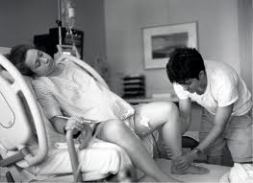Following my thoughts on fetal scalp electrodes (FSE’s) and remember they are only my thoughts, I am no authority on these things but I feel I need to vent them. Writing them down clarifies it in my mind. Input from my followers out there are most welcome!
So following my thoughts on FSE’s I now want to clear it in my mind about electronic fetal monitoring (EFM), or CTG’s if you like.
A little history first: EFM was introduced in the late 1960’s based on the assumption of efficacy but meta-analysis conducted in the 1990’s clearly indicated the use of EFM increased the rate of C-sections and instrumental deliveries. Without improving perinatal outcomes in full-term pregnant women who presented without risk factors for adverse perinatal outcome. So it is now thought that EFM should only be used when risk factors are present for adverse perinatal outcomes or when intermittent auscultation findings are abnormal.
Some of my thoughts around EFM is that although EFM is to be only used on women presenting with risk, this is not always the case; some women still get an admission traces, once an epidural is sited there’s a risk and EFM monitoring is required. These events can then in turn make a fetus without risk seem like being at risk because a long trace > 20mins may display some abnormal or atypical fetal heart rate (FHR) tracings. A healthy fetus can display both transient and repetitive hypoxia in labour. In fact 80% of labours result in abnormal or atypical FHR tracings at one time or another without signifying life-threatening situations (Umstad et al 1994). So where lies the cut off between a trace being suspicious to be considered abnormal and finally pathological.
I was particularly interested in finding out about these differences in second stage labour, this information I found difficult to find but this is what I finally came up with, which clarified it in my mind:
When to wait:
- FHR and uterine activity is sufficiently clear to determine both (but in second stage this can be very difficult, often a maternal heart rate can be heard instead of the FHR – change position, unfortunately this often excludes the more favourable active positions)
- Variability is >50% of tracing, never below minimal and not decreasing over time
- Spontaneous or elicited (with vibroacoustic or scalp stimulation) acceleration every 20-30 mins ( – this is new to me, especially the vibroacoustic stimulation, – also that scalp stimulation is a good sign; in future I will definitely be recording such events)
- Occasional late decelerations without repetition that are abolished with correction of position change, delayed pushing, hypotension and cessation of oxytocin
- Variable decelerations that return to baseline abruptly, without persistent late components
- FHR baseline is not increasing
- Absence of repeated prolonged decelerations (>3 mins but <10mins)
When to worry:
- Previously “put on notice” during first stage labour
- Patterns that qualify as non-reassuring and cannot be corrected
- Non-reassuring patterns such as:
- persistent late decelerations (≥50% of contractions)
- non-reassuring variables, progressively severe with developing tachycardia, loss of variability, or slow return to baseline
- Sinusoidal tracing
- Recurrent prolonged decelerations
- An unusual or confusing pattern that does not fit one of the catagories define above, but does not have elements of reassurance
Corrective management:
- Change position of woman to improve FHR
- Discontinue oxytocin administration
- Bolus of appropriate fluid to maximise intravascular volume
- Vaginal examination to rule out cord prolapse, imminent or remoteness of delivery (at the same time see what results from the scalp stimulations on the FHR)
- Consider passive decent if the FHR is amendable and pushing exacerberates the problem
- Consider pushing only every 2nd or 3rd contraction
- Decist from pushing and assist to a side-lying position, allow 20-30 mins recovery (unless terminal pattern present)
- If FHR persistently is non-reassuring – deliver expeditiously
(Freeman 2003)
All of the above should be in working collaboratory with the obstetric team, and them with the responsible midwife. So as a midwife it is imperative that this is clear in my mind so that I don’t feel that my client is being railroaded into an unnecessary instrumental delivery or c-section.

Additional clarifications for definitions of typical and atypical decelerations according to NICE:
Typical decelerations:
- Shouldering before and after, including quick recovery
- Ok to have these decelerations for 90 mins in >50% of contractions before classified as a non-reassuring feature
(Document as normal per NICE guideline, however to monitor closely)
Atypical decelerations:
- No shouldering and deceleration lasts longer in >50% of contractions
- Late decelerations in >50% of contractions
- If lasted for >30mins classed as abnormal/pathological
Additional things to think of with decelerations and what they signify:
Early decelerations = head compression
Variable decelerations (typical and atypical) = cord compression
Late decelerations = placental insufficiency
 is where the women have supportive partners and birth partners who understands that labour is not an illness but more of a quest that the woman has to go thru. Those partners give encouragement, they make the environment nice with music and lighting, take them for walks, gives them cuddles and kisses, they rub their back /feet /cramps /hands /scalp /shoulders, ensure they hydrate, take snacks and shield them from the world making them feel safe. If this is in place, it doesn’t really matter who the midwife is.
is where the women have supportive partners and birth partners who understands that labour is not an illness but more of a quest that the woman has to go thru. Those partners give encouragement, they make the environment nice with music and lighting, take them for walks, gives them cuddles and kisses, they rub their back /feet /cramps /hands /scalp /shoulders, ensure they hydrate, take snacks and shield them from the world making them feel safe. If this is in place, it doesn’t really matter who the midwife is.




